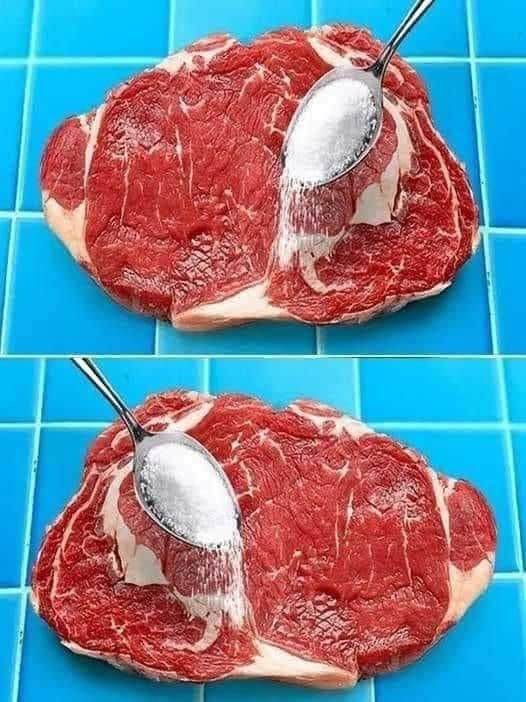ADVERTISEMENT
ADVERTISEMENT
Step 1: Salt Tenderization
Salt is the cornerstone of this recipe. It not only enhances flavor but also helps tenderize the meat through a process called osmosis.
Here’s how to do it:
Lay the steak flat on a tray or plate.
Sprinkle 1 tbsp of kosher salt on each side.
Let the steak sit at room temperature for 45-60 minutes.
What happens during this time?
Salt draws moisture out of the steak.
The moisture dissolves the salt, forming a brine.
This brine is reabsorbed into the steak, breaking down tough muscle fibers.
Tip: Avoid using iodized table salt, as it can make the steak overly salty.
Step 2: Rinse and Dry
After the steak has rested, it’s crucial to rinse off the excess salt.
Rinse under cold water for 10-15 seconds.
Pat the steak dry thoroughly with paper towels.
ADVERTISEMENT
Why is this important? A dry surface ensures a perfect sear later, locking in juices and creating a flavorful crust.
Step 3: Season the Steak
Once your steak is dry, it’s time to add a savory seasoning blend.
Rub olive oil on both sides of the steak.
Mix garlic powder, onion powder, black pepper, and optional herbs.
Press the seasoning into the meat gently to ensure it adheres.
This simple blend enhances the meat’s natural flavors without overpowering them.
Step 4: Cooking the Perfect Steak
You have several options when it comes to cooking your steak. Regardless of the method, always allow the meat to come to room temperature before cooking.
ADVERTISEMENT
Savory Steak Tenderization Recipe
Pan-Searing Method:
Preheat a cast-iron skillet until it’s smoking hot.
Sear steak for 2-3 minutes per side.
Finish in a preheated oven at 400°F for 5-7 minutes.
Grilling Method:
Preheat the grill to high heat.
Cook steak for 3-4 minutes per side.
Move to indirect heat to finish cooking.
Use a meat thermometer to check doneness:
Rare: 120-125°F
Medium-rare: 130-135°F
Medium: 140-145°F
Medium-well: 150-155°F
Well-done: 160°F and up
Pro Tip: Always rest the steak for 5-10 minutes before slicing. This allows the juices to redistribute evenly.
Step 5: Slicing and Serving
How you slice your steak can make a big difference in texture. Always cut against the grain to shorten the muscle fibers and ensure tenderness.
Serve with:
Roasted vegetables
Garlic mashed potatoes
Herb butter or chimichurri sauce
A bold red wine like Cabernet Sauvignon
Additional Tenderizing Techniques
While salt tenderization is powerful, here are some other methods you can combine or try separately:
Mechanical tenderizing – Use a meat mallet to break down tough fibers.
Acidic marinades – Use vinegar, lemon juice, or yogurt to help soften the meat.
Enzymatic tenderizers – Pineapple or papaya contain natural enzymes like bromelain and papain.
Sous vide cooking – Low and slow cooking in a water bath ensures even tenderness.
Common Mistakes to Avoid
Skipping the resting time: Salt needs time to work its magic.
Over-salting: Measure your salt carefully and don’t use fine salt.
Not drying the steak: A wet surface prevents proper browning.
Overcooking: Use a thermometer to get it just right.
Final Thoughts
With this savory steak tenderization recipe, you’re not just cooking dinner—you’re crafting an experience. Tenderizing with salt and seasoning thoughtfully unlocks rich flavors and textures that rival any steakhouse.
Whether you’re serving it for a special occasion or a casual weeknight meal, mastering this method will make steak a staple in your kitchen. Ready to impress? Fire up that pan or grill and enjoy every juicy, flavorful bite.
ADVERTISEMENT
